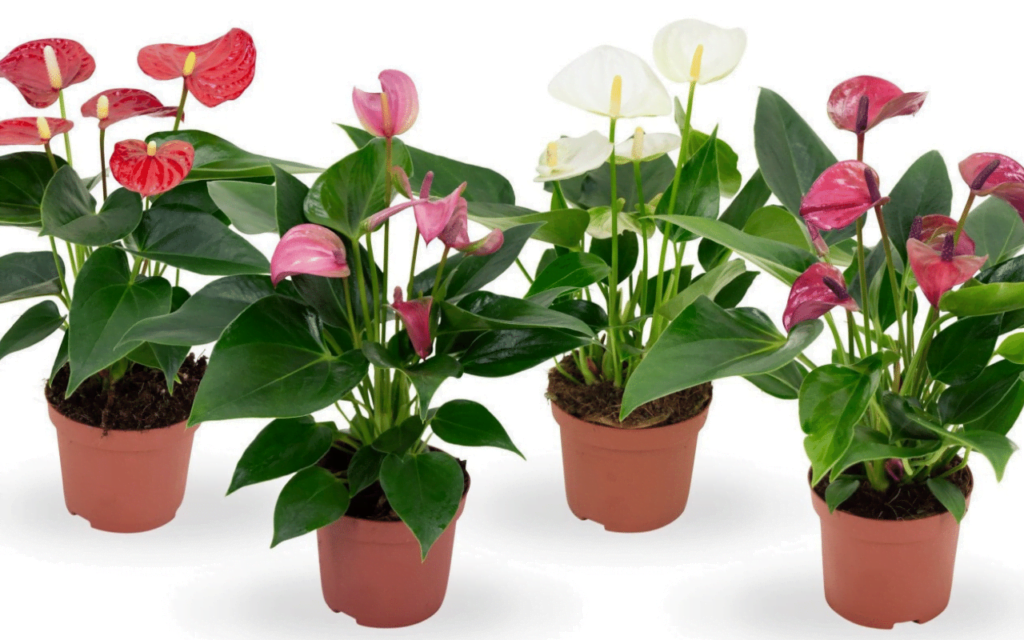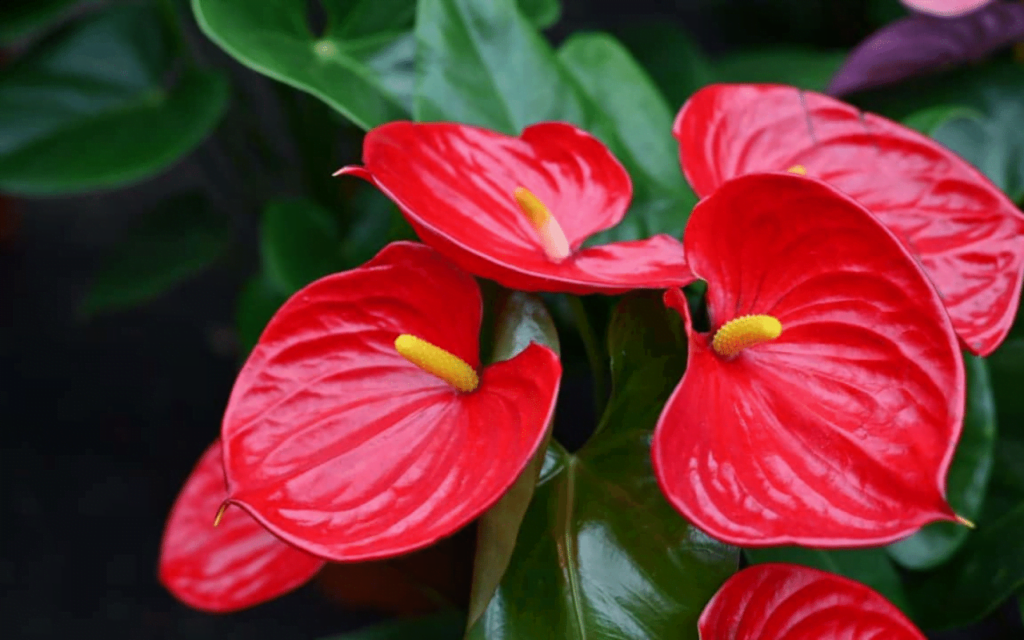Introduction
The Indoor Plant Flamingo Lily, scientifically known as Anthurium, is more than just a pretty face. This bright and cheery houseplant, adorned with heart-shaped leaves and spectacularly vibrant blooms, is an attractive addition to any indoor garden. In the following comprehensive informative, we delve deep into the proper care and considerations to ensure your Anthurium thrives for years to come
Flamingo Lily (Anthurium) Indoor Plant Details
| Specification | Description |
|---|---|
| Common Names | Flamingo Lily, Laceleaf, Tailflower |
| Botanical Name | Anthurium andraeanum |
| Family | Araceae |
| Plant Type | Evergreen perennial |
| Mature Size | Typically reaches a height of 1-2 feet (indoors) with a similar spread, but can be larger in the wild. |
| Sun Exposure | Prefers bright, indirect light. Avoid direct sunlight as it can scorch the leaves. |
| Soil Type | Well-draining, lightweight potting mix. A blend of peat moss, pine bark, and perlite is ideal. |
| Soil pH | Slightly acidic to neutral; a pH of 6.0 to 7.5 is optimal. |
| Bloom Time | Can bloom year-round when given optimal conditions, but most commonly flowers in spring and fall. |
| Flower Color | Most commonly seen in red, but varieties can range from pink, white, lavender, and even chocolate. |
| Hardiness Zones | Typically 10-11 for outdoor planting. As an indoor plant, it thrives in controlled environments. |
| Native Area | Native to the tropical rainforests of Central and South America. |
The Flamingo Lily (Anthurium) is a captivating indoor plant renowned for its vibrant, heart-shaped blooms and deep green, glossy foliage. The specifications outlined provide a comprehensive understanding of its botanical background and care preferences, ensuring enthusiasts can appreciate and tend to its tropical beauty with ease.
Plant Care
At the heart of owning any houseplant is understanding its fundamental care needs. The Flamingo Lily, like any other plant, requires a delicate balance of light, soil, water, and other factors. When catered to correctly, it rewards its owner with a lush, tropical aesthetic that instantly elevates a room’s ambiance.
Light
The Anthurium craves bright, indirect light. Direct sunlight, especially during the hot afternoons, can be too harsh and can cause the plant’s leaves to burn. A spot near a window with sheer curtains or a location where it receives filtered sunlight is ideal. If your home isn’t blessed with copious amounts of natural light, a fluorescent light can serve as a decent substitute, ensuring the plant gets at least six hours of light each day.
Soil
The Flamingo Lily, native to the tropical rainforests of Central and South America, prefers a well-draining soil mixture. A blend of peat moss, pine bark, and perlite creates the perfect environment for the roots to grow without staying waterlogged. Remember, a pot with good drainage holes is crucial. This prevents root rot, ensuring that your plant remains vibrant and healthy.
Water
Overwatering is a common mistake for many Flamingo Lily enthusiasts. This plant prefers its soil to be kept consistently moist but not soggy. Watering should be moderate, ensuring that the top inch of the soil dries out between watering sessions. Using lukewarm water can be beneficial, as cold water might shock the plant’s system.
Temperature and Humidity
These tropical beauties thrive in warmer temperatures, ideally between 65°F to 70°F. They can tolerate a little dip occasionally, but it’s best to avoid temperatures below 50°F. The Flamingo Lily also loves humidity. Regular misting, placing a humidifier nearby, or placing the pot on a tray with water-filled pebbles can help maintain a high humidity level, mimicking its native tropical environment.
Fertilizer
To keep the Flamingo Lily’s growth robust and its blooms vibrant, regular feeding is essential. A balanced liquid fertilizer, diluted to half its strength, applied every six weeks during its growing season (spring and summer), can do wonders. Remember to reduce feeding during the colder months as the plant’s growth slows down.
Pruning
Regularly pruning the Anthurium helps maintain its appearance and overall health. Remove yellow or brown leaves and spent flowers to encourage new growth and blooms. This not only ensures the plant looks its best but also diverts energy to the healthier parts of the plant.
Overwintering
Though the Flamingo Lily is not a fan of the cold, with a little care, it can sail through the winter months unscathed. Ensure that it’s kept away from drafts or cold windows. While it requires less water during these months, make sure the humidity level remains consistent.
Propagating Plant
Propagation is a delightful way to multiply your Flamingo Lily collection. The easiest method involves dividing the plant during repotting. Gently separate the root clusters, ensuring each section has a few leaves and roots, and plant them in individual pots. With the right care, these divisions will grow into full-sized plants.
Types of Flamingo Lily
The Anthurium genus, often referred to as the Flamingo Lily, encompasses a wide variety of species, each boasting its distinct charm. Here are some popular types:
- Anthurium andraeanum: Perhaps the most renowned, this variety showcases bright red, heart-shaped spathes and glossy foliage.
- Anthurium scherzerianum: Recognized for its spiral-shaped spadix, it offers a delightful range of spathe colors from red to pink and even white.
- Anthurium crystallinum: This variety is sought after for its velvety, heart-shaped leaves with contrasting white veins.
- Anthurium clarinervium: A lover of shade, this type mesmerizes with its thick, heart-shaped leaves, each showcasing a unique pattern of prominent white veins.
Common Pests & Plant Diseases with Solutions
Flamingo Lilies, like most plants, are susceptible to specific pests and diseases:
- Aphids: These tiny pests suck sap from the plant, causing weakened growth. Solution: Wipe them off with a cloth dipped in soapy water or use insecticidal soap.
- Mealybugs: Recognizable by their white cottony appearance, they can stunt growth. Solution: Remove manually using a cotton swab dipped in alcohol or introduce natural predators like ladybugs.
- Root Rot: This is often caused by overwatering and poor drainage. Solution: Ensure well-draining soil and proper watering routine. If noticed, remove the affected roots and repot the plant in fresh soil.
- Leaf Spot: Caused by fungi, it manifests as brown spots on the leaves. Solution: Ensure good airflow, water at the base, and avoid wetting the leaves. Fungicidal sprays can also be used.
How to Get Flamingo Lily to Bloom
Flamingo Lily blooms are a sight to behold, and ensuring they bloom requires specific steps:
- Proper Light: Ensure they receive bright, indirect light, which stimulates the production of blooms.
- Fertilization: Regularly feed with a balanced liquid fertilizer during the growing season to provide essential nutrients.
- Pruning: Remove spent flowers to encourage the growth of new blooms.
- Right Temperature: Maintaining a consistent temperature between 65°F to 70°F can encourage blooming.
Common Problems With Flamingo Lily
Every plant has its quirks, and the Flamingo Lily is no exception. Here are some common issues and their solutions:
- Yellowing Leaves: Often a sign of overwatering. Ensure your watering routine is consistent and the pot has proper drainage.
- Drooping Leaves: This can be a sign of both overwatering and underwatering. Check the soil’s moisture levels and adjust accordingly.
- Lack of Blooms: This can be due to insufficient light or nutrients. Move to a brighter location and ensure regular feeding.
- Brown Tips: Usually a sign of low humidity. Mist regularly or use a humidifier.
As we continue to explore the depths of the Flamingo Lily’s world, it’s clear that this plant is a mix of vibrant beauty and delicate care needs. Addressing the potential problems, understanding its various types, and ensuring it blooms to its fullest potential are all part of the fulfilling journey of owning an Anthurium.
Quickly Declining
While the Anthurium is relatively resilient, it can show signs of distress. Yellowing leaves, wilting, or a lack of blooms might signal issues like overwatering, insufficient light, or pests. Regularly inspecting your plant and understanding its needs can prevent such decline and ensure it remains in peak condition.
A Bright Future: Final Thoughts
The Flamingo Lily, with its radiant blooms and lush foliage, is a testament to nature’s beauty. While it demands specific care requirements, the rewards—both aesthetically and emotionally—are immense. With the right love and attention, your Anthurium will not only survive but thrive, bringing a slice of the tropics right into your living space.
Frequently Asked Questions
Decode the magic of gardens with our guide to Landscaping Styles Frequently Asked Questions.
- With optimal care, the Flamingo Lily can bloom multiple times a year, with each bloom lasting for several weeks.
- Yes, they can be toxic when ingested by pets, causing digestive distress. It’s best to place them out of reach of curious pets.
- Repotting every 2-3 years is ideal, especially if you notice the roots outgrowing the pot or the soil becoming too compacted.
- Brown tips can be a sign of underwatering, low humidity, or a buildup of minerals from tap water. Adjusting your watering routine and ensuring sufficient humidity can help address this issue.
Recent Posts
- Modern Mural Ideas Transforming Walls into Artworks
- Thematic Table Decor Dressing Your Table for Special Occasions
- Festive Lighting Ideas Brightening Your Home for the Holidays
- Biodegradable Decor Materials Choosing Earth-Friendly Options
- Personalized Space Decor Making Your Home Uniquely Yours
- New Year’s Eve Decor Ringing in the New Year in Style
- Transforming Junk into Decor Upcycling at Its Best
- Second-Life Decor Objects Giving Old Items New Purpose
- Unique Decoration Crafting Standout Ideas for Your Home
- Environmentally Friendly Styling Decor with a Conscience











